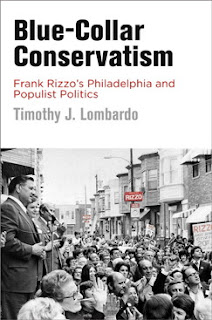
He applied the “Page 99 Test” to his new book, Blue-Collar Conservatism: Frank Rizzo’s Philadelphia and Populist Politics, and reported the following:
Blue-Collar Conservatism: Frank Rizzo’s Philadelphia and Populist Politics examines post-World War II Philadelphia to explain how working- and middle-class whites turned to the right in the last half of the twentieth century. It focuses on the white ethnic and blue-collar supporters of Frank Rizzo, Philadelphia’s controversial police commissioner turned mayor in the 1960s and 1970s. Rizzo was an archetypal example of late twentieth-century populist conservatism and a champion of “law and order.” As police commissioner, Rizzo earned a national reputation for his tough stance on crime, the heavy-handed tactics of his police force, and his openly hostile treatment of civil rights activists. Page 99 finds then-Deputy Commissioner Rizzo commanding the police response to civil rights protests demanding the integration of Girard College, an all-white boarding school for orphaned boys in the heart of all-black North Philadelphia.Learn more about Blue-Collar Conservatism at the University of Pennsylvania Press website.
Page 99 begins by describing Girard College as looking “like a fortress, with high white walls protecting expansive grounds and mansion-like structures from the surrounding neighborhood” and calling the boarding school an “architectural manifestation of African Americans’ exclusion from the city’s white power structure.” Willed as a whites-only institution by nineteenth-century financier Stephen Girard, the integration of Girard College had long been a goal of Philadelphia’s African American community. By the mid-1960s, the effort to integrate Girard College came under the direction of the fiery leader of local NAACP, Cecil B. Moore. Outspoken and brash, Moore led daily marches outside Girard College between May and December of 1965. While his marches and speeches inspired civil rights activists, they also drew the anger of white Philadelphians that viewed Girard College as a cherished local tradition. Moore’s protests also brought him face-to-face with Frank Rizzo. The regular confrontations secured Moore’s role as the leader of the more militant movement for civil rights in Philadelphia. They also established Rizzo’s reputation as a protector of tradition among white, blue-collar Philadelphians.
The snapshot of Rizzo and Moore outside the walls of Girard College hints at the conflict at the heart of Blue-Collar Conservatism. While maybe not fully revealing “the quality of the whole,” page 99 provides a glimpse of the book’s central focus on the various ways blue-collar whites reacted and responded to the changes wrought by the civil rights movement. It also offers an early look at why Frank Rizzo became such an important figure in Philadelphia’s white blue-collar politics and the broader rise of blue-collar conservatism.
--Marshal Zeringue



